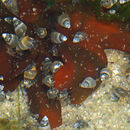Biology
provided by Arkive
This snail is often found in extremely high densities; up to 300,000 individuals have been recorded per square metre (1). When covered by the tide, it floats upside down on the surface of the water on a 'raft' of mucus (2). When the tide has gone out, this snail often climbs up vertical objects in order to browse (1). It feeds on silt, fungi, and diatoms, which it scrapes from the sediment surface with the radula, a narrow structure in molluscs that bears teeth and is used to rasp food (2). When floating, the snail also feeds on particles that become trapped in the mucus raft (2).
Breeding occurs in spring and autumn (1); the sexes are separate, and fertilisation occurs internally (2). Egg masses of 4-8 eggs are usually cemented onto the shells of other laver spire snails and become covered with a protective layer of sand grains (2). There is some dispute as to the biology of the larval stage; research has shown that the larvae are planktonic, whereas other researchers have found that there is no planktonic stage, and that the larvae live on the substrate (1).
Conservation
provided by Arkive
One of the major habitats supporting this species, mudflats, is a priority habitat under the UK Biodiversity Action Plan (UKBAP). It therefore has a conservation Action Plan. Many mudflats are protected by UK and European legislation, and have been designated as protected areas including Sites of Special Scientific Interest (SSSIs), Special Protection Areas (SPAs) and Special Areas of Conservation (SACs). Mudflats and sandflats are listed as an Annex 1 habitat under the EC Habitats Directive (3).
Description
provided by Arkive
The laver spire snail, also known as the mudsnail, has a small, spiralling shell, which is brown to yellow in colour. The snail is grey with spots of pigment (1), and the tentacles are pale with a dark patch towards the tips (2).
Habitat
provided by Arkive
This species is found on mudflats, muddy sand, in estuaries (2) and in saltmarshes (1); it is most common on the middle and upper parts of the shore (2), although it has been found at depths of 100 metres (1). It is often associated with sea-grass beds (1).
Range
provided by Arkive
Widely distributed around all of the coasts of Britain. It is also found in north-west Europe (2).
Status
provided by Arkive
Common and widespread.
Threats
provided by Arkive
Not currently threatened.

